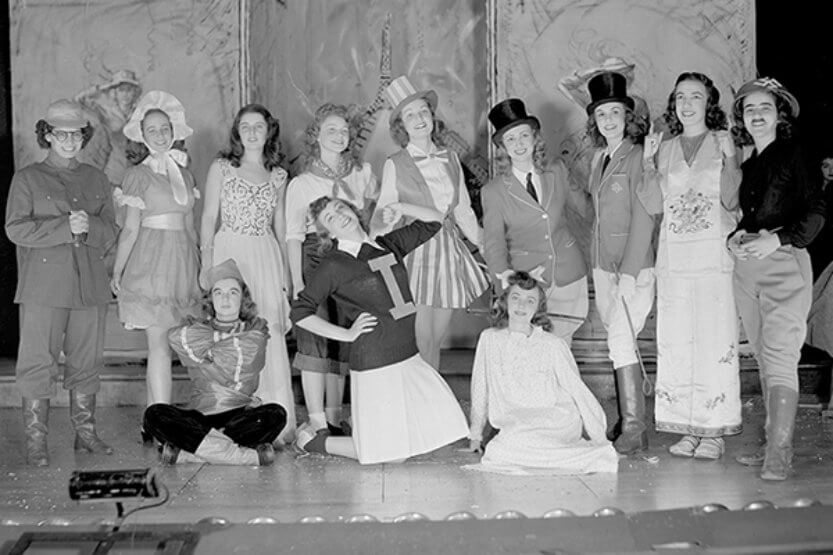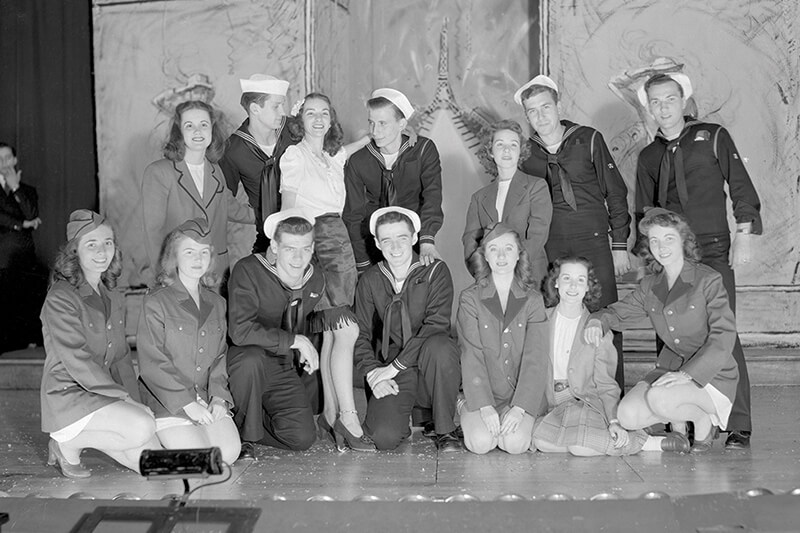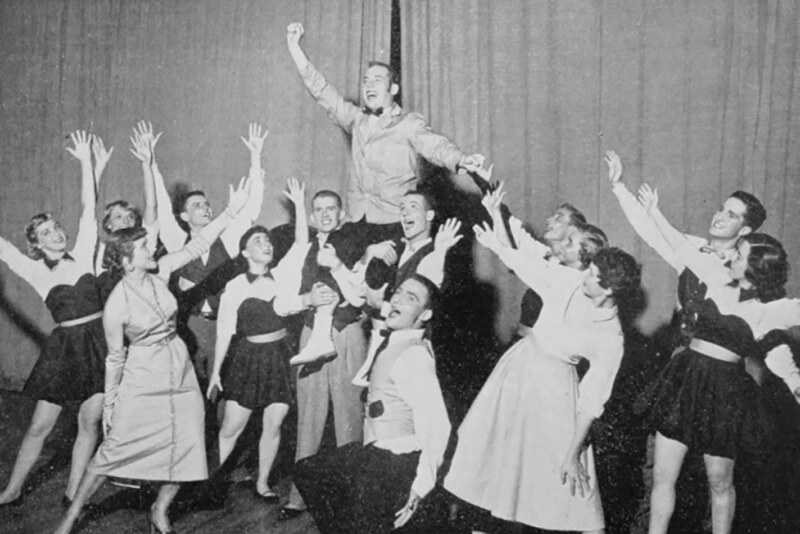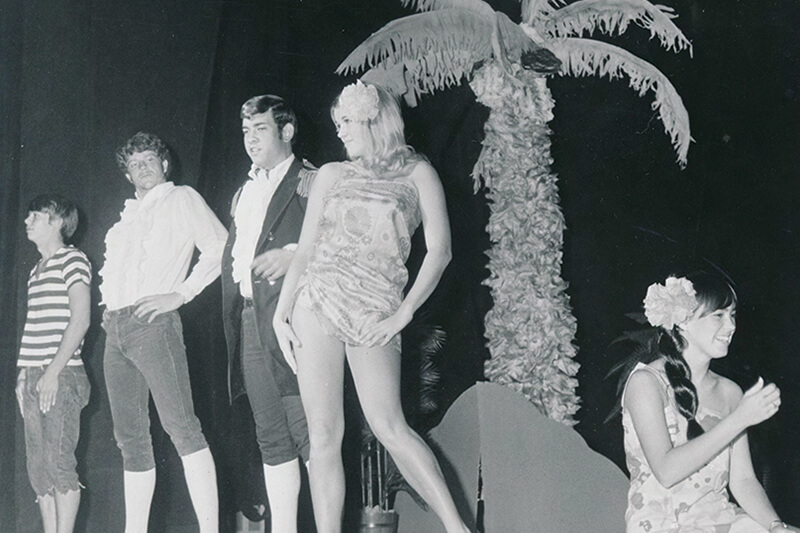Memory Lane: The Stunt Show
 The Stunt Shows were part of Homecoming for almost 60 years, and frequently parodied pop culture, national affairs and campus issues. Seen here, co-eds dressed as the Allied and Axis powers (1944). (Image courtesy of UI Archives)
The Stunt Shows were part of Homecoming for almost 60 years, and frequently parodied pop culture, national affairs and campus issues. Seen here, co-eds dressed as the Allied and Axis powers (1944). (Image courtesy of UI Archives) On a Homecoming weekend in the mid-1960s, Bill Lewke, ’66 BUS, gamely played an elephant before thousands of amused parents, students and alumni in Assembly Hall. His fraternity and a sorority staged a funny skit about Noah’s Ark. Another year, in an inventive spoof about fraternity rush, he played an archangel, determined to persuade freshmen to study and stay on the straight and narrow. A red-headed sorority co-ed played Lucifer, intent on leading first-year students astray.
Held until 1969, the popular Stunt Show was a staple of Homecoming for a half-century. “If you were in the show, it seemed everyone knew who you were,” Lewke says. He adds with a laugh, “It was a great way to be around gals.”
Students staged skits that parodied popular culture, comically referenced campus issues and national affairs, and gently lampooned campus administrators. In addition to a steady stream of double entendres, an avalanche of puns and a mildly rebellious attitude against the mores of the times, students also displayed their singing, dancing and acting skills.
Run by the UI Student Union, the Stunt Show was part variety show, part Laugh-In and wholly a product of a University that was decidedly more cohesive and more culturally monolithic back then. Everyone got the jokes. Everyone wanted to be there. “We were a Big 10 school, and proud of that. There was a real rah-rah spirit,” Lewke says.
“You wanted to be part of things on campus,” adds Jim Finnerty, ’67 MEDIA, MS ’72 MEDIA. “It was ‘Let’s see Joe, my fraternity brother (on stage).’ What else would you do with your parents at Homecoming on Saturday night?”
Through the years, the show mirrored the times. In the 1960s, there was a send-up of an Imperial margarine TV commercial and a psychedelic romp titled, “Something for Everybody Including Nobody.” In 1944, students dressed as U.S. sailors did a song and dance. In 1922, co-ed Margaret Beatty, appearing in “an array of colorful costumes,” according to the yearbook, portrayed the court of Henry VI.
In 1918, because of the influenza pandemic, there were no Homecoming events other than the game. So the ante was upped the next year with an especially elaborate Victory Homecoming, including a new variety show in the Armory. The Co-ed Comeback Carnival, featuring vaudeville and cabaret, was a hit from the start. The Illinois Alumni News in 1920 proclaimed that the carnival “ranked closest with the football game in attendance and excitement. … The various stunt sideshows and stunt theaters were so continuously crowded that about all the peacefully inclined grad could do was to walk around and try to find somebody he knew.”
Some students in the shows had participated in high school plays or had performing talent. In 1942, student Allan Sherman, later famous for his comedy records (“Hello Muddah, hello Faddah, here I am at Camp Grenada”), honed his talents in the Stunt Show, winning first prize with his parody song, “Don’t Burn Down Bidwell’s!” To the tune of “Won’t You Come Home, Bill Bailey,” he rhapsodized about the popular student watering hole:
Burn down the football stadium,
Huff Gym as well,
But, please, boys, don’t burn down Bidwell’s!
The next year, Sherman topped himself with a memorable parody of the title song from the musical Oklahoma! He incorporated the war into his verses: “Yooookohama, where the planes come sweeping through the wind!” The professor in charge of the show had forbidden Sherman to perform the parody without permission from the composers. Amazingly, Sherman was able to get songwriter Richard Rodgers on the phone, and he gave the OK.
Gradually, as the Greek system on campus grew, the show became strictly a showcase for fraternities and sororities. In the spring, they’d pair up, write a skit and enter a try-out. The 16 finalists performed in the fall after many rehearsals.
In the 1960s, Ned Levy, a local high school English teacher, directed the show, and Charles DeLaney, a UI music professor, coordinated the music. A favorite part of the show was the shag line, in which two dozen or so students paraded across the stage between acts. They bought time for the next act but also used the opportunity to sing, tell jokes or flash funny signs. “The show was very professional,” recalls Finnerty, now a successful television broadcaster. “It wasn’t like a typical high school show. The sets were good. The costumes were good.”
In 1969, the University official in charge of the Stunt Show abruptly decided to replace it, at least that year, with a magic show. The following spring brought the Kent State shootings and anti-war violence to campus. Suddenly, the Stunt Show seemed passé. “That was a watershed year. The campus flipped overnight. The show definitely was a thing of its time,” recalls one alumnus from the 1960s.
Lewke’s son, Jay Bradley, ’76 BUS, became a UI student and joined the same fraternity. “He did everything I did,” Lewke says. “But the Stunt Show was gone.”





